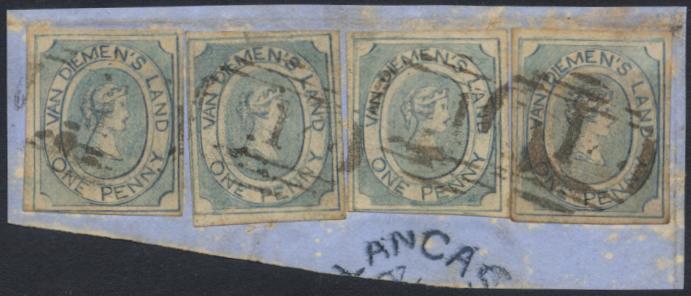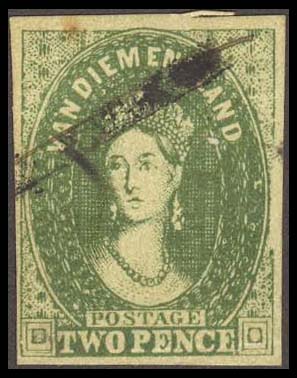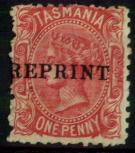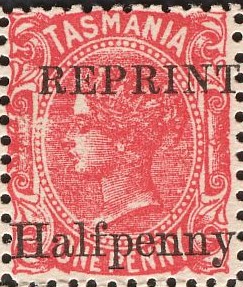Wmk. 6 - Large Star
Return To Catalogue - Tasmania 1892-1900 and miscellaneous - Australia
Note: on my website many of the
pictures can not be seen! They are of course present in the cd's;
contact me if you want to purchase them: evert@klaseboer.com.
1 p blue 4 p orange
Value of the stamps |
|||
vc = very common c = common * = not so common ** = uncommon |
*** = very uncommon R = rare RR = very rare RRR = extremely rare |
||
| Value | Unused | Used | Remarks |
| 1 p | RRR | RRR | |
| 4 p | RRR | *** | Cut into octagonal shape With full border: RR |


(Reprints of the 1 p and 4 p stamps with defacing lines)
I've seen a whole sheet of the 1 p reprints
consisting of four rows of six stamps (24) with the same two
(also three) lines through the design. They seem to have been
printed from the defaced copper plate on thick wove paper.
A similar reprint (with the defaced plate with lines) exists for
the 4 p (see the picture above).

Reprint sheet
The next 4 p stamps look very suspicious to me, they are most likely forgeries:
Other forgeries with "CORREOS" cancel (possibly a forgery made by Spiro, I have also seen it with other 'Spiro' cancels):


This "CORREOS 7.1.60. II-III" forged cancel, usually
appears on forgeries from South America, but I've also seen it on
forgeries from Hannover for example.
A forgery of the 4 p stamp with "FACSIMILE." overprint (made by Senf):


A forgery with the lettering too small, note that the '2' above
the stamp is also imitated to indicate the sheet position. I've
seen it with a 'TASMANIA' in between bars cancel.
The next forgeries of the 1 p were made by Jeffryes:

(Four 1 p forgeries on piece with barred numeral '1' cancel)
Jeffreys also made an engraved forgery of the 4 p value; the ink stands out too clearly, the 'CWC' at the bottom of the neck is too clear. It is also smaller than the genuine stamps. I've seen it with a numeral '75' cancel. Sorry, no picture available yet.


Here another Jeffreys forgery together with some engraved 4 p
forgeries (also from Jeffreys?).



(Some primitive 1 p forgeries)

Another forgery with smaller inscriptions (the words don't touch
the elliptic lines below and on top of it).
1 p red 2 p green 4 p blue Those stamp exist watermarked with wmk.6, 49 & 75, and also unwatermarked. Perforated
1 p red 2 p green 4 p blue The stamps are perforated: 10 (1864-1869) 12 (1864-1891) 10x12 (1864-1891) 12½ (1864-1891) 11½ (1864-1891) pin-perf. 5½ to 9½ (1867) pin-perf. 13½ to 14½ (1867) oblique roulette 14-15 (1867) oblique roulette 10-10½ (1867) oblique roulette imperf 10-10½ (1867) serrate perf. 19 (1868)
My collection:
1 p orange red, perforated 10 with perforations trimmed on the botom.
Value of the stamps |
|||
vc = very common c = common * = not so common ** = uncommon |
*** = very uncommon R = rare RR = very rare RRR = extremely rare |
||
| Value | Unused | Used | Remarks |
| With watermark 'Large Star', imperforate (1855) | |||
| 1 p | RRR | RRR | |
| 2 p | RRR | RR | |
| 4 p | RRR | R | |
| With no watermark, imperforate (1856) | |||
| 1 p | RRR | RRR | |
| 2 p | RRR | RRR | |
| 4 p | RRR | RR | |
With watermark 'Number', imperforate (1857) |
|||
| 1 p | *** | * | Watermark '1' |
| 2 p | R | ** | Watermark '2' |
| 4 p | R | * | Watermark '4' |
| With Watermark 'Number', various perforation gauges (1864) | |||
| 1 p | *** | * | Watermark '1' Exists with no watermark or watermark '2' |
| 2 p | RR | *** | Watermark '2' |
| 4 p | R | ** | Watermark '4' |
Many of these stamps are used fiscally. Postally used stamps are in some cases rarer.
Examples:

(Reduced size, reprint on a thick card)
I've also seen reprints of the 2 p green stamp (imperforate without "REPRINT" overprint, and perforated with "REPRINT" overprint)..
Examples:




I've seen this forgery with a 'CORREOS' cancel as well.


Some kind of a cut out with a black on yellow 1 p forgery; front
and back are shown.

Forgery with very small "VAN DIEMENSLAND"
I have seen an imperforate proof, 1 p red (carmine) on thick paper, no watermark, imperforate with gum added pretending to be an issued stamp.
Imperforated
6 p lilac to blue 1 Sh red Perforated


6 p lilac to blue 1 Sh red The stamps are perforated: 10 (1864-1869) 12 (1864-1891) 10x12 (1864-1891) 12½ (1864-1891) 11½ (1864-1891) pin-perf. 5½ to 9½ (1867) pin-perf. 13½ to 14½ (1867) oblique roulette 14-15 (1867) oblique roulette 10-10½ (1867) oblique roulette imperf 10-10½ (1867) serrate perf. 19 (1868)
Value of the stamps |
|||
vc = very common c = common * = not so common ** = uncommon |
*** = very uncommon R = rare RR = very rare RRR = extremely rare |
||
| Value | Unused | Used | Remarks |
| With watermark 'Number', imperforate (1857) | |||
| 6 p | RR | ** | |
| 1 Sh | RR | * | |
| With watermark 'Number', various perforation gauges (1864) | |||
| 6 p | R | * | |
| 1 Sh | *** | * | |

(Watermark on the 6 p: '6')

'12' watermark on the 1 Sh, reduced size
Many of these stamps are used fiscally. Postally used stamps are in some cases rarer.

(Fiscally used stamp, reduced size)
Reprints exist, they have a large "REPRINT" overprint:

(Reprint of the 6 p, reduced size)
I've also seen imperforate reprints without the "REPRINT" overprint of both values.

Two reprints of the 1 Sh on thick paper without
"REPRINT" overprint
Proofs:

Two proofs with different bottom parts, reduced size.
Forgeries:


Forgeries; I've also seen this forgery with a circular cancel.
1/2 p orange 1 p red 2 p green 3 p brown 4 p blue 4 p yellow 4 p olive 8 p brown 9 p blue 10 p black 5 Sh lilac Surcharged
'Halfpenny' on 1 p red (for newspapers) '2 1/2 d.' on 9 p blue
Various perforation gauges were used for these stamps. The first stamps were issued with watermark 'Number'. Later, in 1871, the watermark 'TAS' was used. Specialists distinguish two types of this watermark with different sizes: 16x7 mm or 13x6 mm. The 9 p was issued in 1902 with watermark 'V Crown'.
Value of the stamps |
|||
vc = very common c = common * = not so common ** = uncommon |
*** = very uncommon R = rare RR = very rare RRR = extremely rare |
||
| Value | Unused | Used | Remarks |
| With watermark 'Number' (1870) | |||
| 1 p | *** | * | Watermark '4' or '10', exists imperforate |
| 2 p | *** | c | Watermark '2', exists imperforate |
| 4 p blue | RR | RR | Watermark '4', printed quantity: 72000 stamps (sold quantity 24000) |
| 10 p | * | * | Watermark '10', exists imperforate |
| With watermark 'TAS' (1878) | |||
| 1/2 p | * | * | Exists imperforate |
| 1 p | * | c | Exists imperforate |
| 2 p | * | c | |
| 3 p | * | * | Exists imperforate |
| 4 p yellow | *** | * | |
| 4 p olive | * | * | |
| 8 p | * | * | |
| 9 p | ** | ** | |
| 5 Sh | *** | * | |
| 1/2 p on 1 p | * | * | Misprint: RRR (see below) Reprints were made in 1901 (no watermark) |
| 2 1/2 p on 9 p | * | * | Two types 14 mm or 15 mm high overprint Reprints were made in 1901 (no watermark) |
| With watermark 'V Crown' (1902) | |||
| 9 p | * | * | Very badly printed |
| With watermark 'Crown A' (1905) | |||
| 8 p | * | * | |
| 9 p | * | * | |

(Forgery of a misprint)
A misprint of the 'Halfpenny' on 1 p red exists, instead of 'Halfpenny' it reads 'H..fpenny' with the letters 'al' vertically. The shown stamp here is a forgery of this misprint!
Typical cancel:

"TASMANIA" in bars duplex cancel
Reprints:


(Reduced sizes)

Official reprint of the 'Halfpenny' on 1d surcharge. Actually the
font size is wrong and the stamp is a locally printed 1d, not the
De La Rue 1d as the original was.
I have also seen a reprint of the 4 p blue stamp (also with "REPRINT" overprint):

What are these (imperforate and overprinted "CANCELLED")?:

"SPECIMEN" overprint:

(Some reprints exist with "SPECIMEN" overprint)
Postal stationery: I have seen a postcard with an impression of a stamps similar to the 1 p red stamp.

Forgery of the 5 Sh, for example the "S" of
"TASMANIA" is different and the face of the Queen is
also not like the genuine stamps.
Tasmania 1892-1900 and miscellaneous.